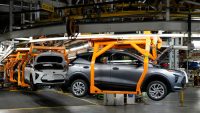 GForces’ Tim Smith says car buyers are ready to buy cars online, but asks is your website?
GForces’ Tim Smith says car buyers are ready to buy cars online, but asks is your website?
In the UK alone 42m consumers are now shopping online, a substantial increase on last year’s statistics. This year dealerships should bring their sales focus off the forecourt and into their digital dealerships to captivate and engage with today’s car buyer.
A staggering 70 per cent of the Top 200 dealers are missing out on the convenience and accessibility of an ecommerce platform. Lifestyle Europe is even taking it one step further and piloting the ability to buy cars online. So with consumers spending more time and money online today why are so many dealers missing out on this growing market?
E-retail sales have seen a 71 per cent growth in the past two years and this is only set to rise. Statistics such as this show a blatant demand from customers. The internet helps identify 65 per cent of potential car dealer consumers, so if this is the channel consumers are using then car dealers need to respond via the same channel. Ecommerce is a great way for dealers to grow a community, entice customers to return and build a loyal customer base.
Like the perfect score to a film, good customer experience is unobtrusive and transparent because it complements the experience. Dealers have already done the hard part and sold the vehicle. The next step is to continue building the customer relationship ensuring that they return for their service, MOT and wiper blades. But that’s just the start of it. The opportunities are endless, retail sales are set to grow a further 36 per cent over the next 18 months alone.
Successful E-businesses like eBay and Amazon are built to generate sales, guiding customers through a seamless site to purchase. Recognising a reduction in delivery and labour costs and today’s buyer behaviour, these businesses understand that with so many advances in technology and increased access to the internet, buying online is easier than owning a credit card or having a PayPal account.
‘It’s important dealers remember these technology advances.’
According to a recent survey by CapGemini, more than half of the 8,000 respondents see practical items likely to wear out as those they are most likely to purchase online. Around 35 per cent of respondents would expect to see some sort of price discount, while 30 per cent believe the transaction would be faster and easier.
Lifestyle Europe may be the UK’s first dealership to pilot the ability to purchase cars online by the click of a mouse. However, a parts and accessories online shop can also be used to market your whole aftersales facility by featuring service offers, winter checks or even offering to professionally fit items purchased from your website.
The benefits, of course, are to increase footfall to your dealership which can result in increased revenue not only to the aftersales departments but also to the sales departments.
Bartlett Seat generated nine per cent more traffic to its website than car portal sites such as Auto Trader and sold cars out of their geographical location all thanks to a link to their dealership site from their online shop.
It’s important dealers remember these technology advances have punctuated the evolution of how consumers search and purchase goods and services. Success is inevitable and demand is already here. Dealers CAN build a simple, affordable and even pre-populated 24/7 online parts and accessories web operation to support their digital dealership.
The UK’s leading dealer groups will implement this as the digital retail market grows, delivering vast amounts of extra revenue to the groups therefore concluding ecommerce as an essential online asset. Other dealers should be listening closely because the word of mouse is ecommerce.
































